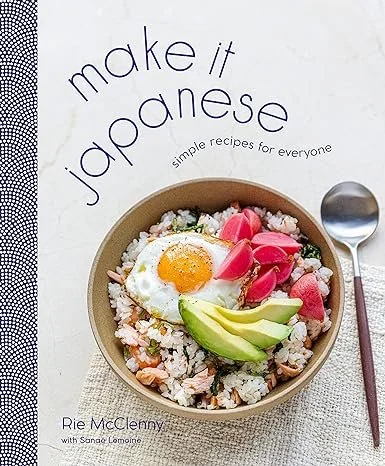japanese home cooking in america
I will admit I don’t have a lot of experience with Japanese food, but when Make It Japanese showed up on my porch one weekend, I was excited to learn more. Author Rie McClenny has a wealth of cooking experience, from working at her grandmother’s café in southwestern Japan as a child (she mostly poured water for tea) to translating for culinary students to running a cookware store in New York City to creating recipes and making cooking videos. She’s been to culinary school, she’s worked in kitchens, and she knows what she’s doing.
But McClenny knows that there are cooks out there like me, who don’t know a lot about Japanese ingredients and techniques. She starts out listing her favorite Japanese ingredients, including the brand names she likes best, and explains what they taste like. She does the same with equipment, explaining what they do and how they make cooking easier. But she doesn’t insist on cooks buying all new equipment. If you have something already that will work, use it. And then she dives into the recipes.
Japanese cooking is clean and doesn’t use a lot of ingredients to create rich, delicious flavors. A lot of these recipes use a dashi as a base, and McClenny offers a couple of different options, one vegan, but also talks about the option of buying instant dashi from an Asian grocery store or online. And then it’s on to vegetable recipes, like the Soy Sauce-Simmered Kabocha (squash), Fried Eggplant with Miso Sauce, Carrot Top Tempura, or a Potato Salad made with a little bit of apple and Kewpie mayonnaise.
She then moves on to recipes for meats and seafoods, like Karaage (Japanese fried chicken), Sweet Soy Sauce Chicken Wings, Curry Rice, Rib-Eye Steak with Shoyu-Garlic Sauce, Ginger Pork Chops, Nikujaga (a beef and potato stew), Parchment-Baked Lemon Miso Salmon, Red Snapper Nitsuke (simmered fish), Shrimp in Chili Sauce, and Sake-Steamed Clams.
And then it’s time for a master class in rice. She takes us through step by step to make sure this staple of Japanese cooking is perfect, whether you’re using a rice cooker or cooking it on the stovetop. There is a Salmon Rice Bowl, Katsu Don (pork cutlets simmered in dashi and eggs and served over rice), Taco Rice (made from the leftovers of last night’s tacos, courtesy of her husband), Garlicky Egg Fried Rice with Bacon, or Mushroom and Carrot Mixed Rice.
There are several recipes for Onigiri, filled rice balls that make a delicious handheld treat. In Japan you can find them in grocery stores or convenience stores, but you can also make your own with tuna or umeboshi (pickled plum) or even just sumac and salt. These can also be used as the basis for a bento box, which is the next lesson. McClenny talks about how to build a bento and even offers a few menu options to give you an idea on putting them together.
Then it’s on to noodles, for the Easy Soy Sauce Ramen, Yakisoba (pan-fried noodles, with the option for substituting spaghetti for the soba noodles with her baking soda hack), Creamy Soy Milk Udon with Pork and Bok Choy, and Camembert Cheese Mazemen with Prosciutto. And she finishes with ideas for gatherings and sweet treats. There is an Edamame and Pistachio Dip, Gyoza with Crispy Wings, Potato and Mushroom Gratin, Miso-Yogurt Roasted Chicken, and Easy Sushi Balls. And you can follow it all up with Matcha Snacking Cake, Almond “Tofu” Pudding, Fruit Salad with Rose Syrup, Strawberry and Sweet Bean Mochi. She even includes recipes for breads like Shokupan (milk bread), Citrus Mochi Doughnuts, Pork Buns, and Egg Salad or Katsu Sandos.
Make It Japanese is filled with recipes and techniques of Japanese cooking. The pages come alive with gorgeous photography and intriguing cooking techniques and flavors. But more than that, it sings with McClenny’s life experiences and love for her home country. She talks a lot about her mother’s cooking, about the foods she loved as a child and tried to replicate with the ingredients she could find here in America. It’s not just the food McClenny loves that she offers to her readers. She offers up her heart on these plates, and lets us have a chance to taste some of the happiness she finds in feeding her family, the same happiness her mother had found all those years before. These recipes are personal. They are memories and warmth and comfort and love, and those who read these words and cook these foods share in that love that McClenny so generously shares.
Clarkson Potter provided me with a free copy of this book (with many thanks); the opinions are my own.




